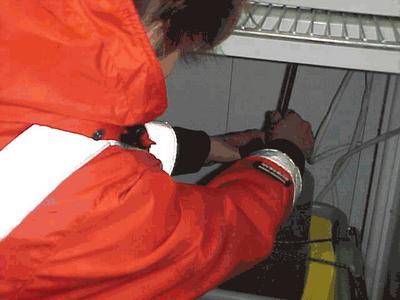29 April, 2003
Do you remember looking at old western movies? Do you remember the
actors wheelin', dealin', and then reelin' in the dough (money)?
Well, those exact three words, wheelin', dealin', and reelin',
describe my experiences today on the fishing cruise only not in the
same order.
First, was the reelin'. The fishing pots had been baited, put out
last night, and left. Today, we reeled them in. Most pots had no
fish. Some pots had one or two fish. It seems the fish weren't
biting the bait.
Second, was the wheelin'. Captain was having a hard time "wheeling"
or maneuvering the ship. The weather was rough and so were the seas.
Waves were crashing on the deck. The two crew members closest to the
edge reeling in the pots had to be tethered so that if either one of
them were swept off of the deck, they could be easily retrieved. The
winds started blowing consistently at 40 knots with gusts up to 60
knots! The waves were so high that when we bottomed a wave out, the
sea was above us! That is a strange thing to see in person. Reeling
had to cease.
Thirdly, dealin'. Since it seems that there will not be enough fish
caught on this cruise for the research that needs to be done. Bruce
and the Captain have been discussing what could be done to rectify
the situation. In other words, what is Plan B going to be? Right
now, they are considering on fishing on the way back to Palmer
Station on the next cruise down from Punta Arenas. The fish that
have been caught will give the scientists plenty to work with until
the ship goes north and returns to Palmer. That is one solution. I
am sure many more brainstorming ideas will be sloshed around in
between time.
Maggie was able to really reel in the amphipods. Her purpose for
coming on the cruise has been accomplished. It seems she discovered
the carnivorous amphipod jackpot!
It was also a very productive experience for me. I was able to see
for the first time how a research vessel's crew cooperates with
scientists helping them to reach their goals.

1. Here the crew and scientists are reeling in the trawling nets.

2. Now, the nets are up. The crew and scientists will open them to see what was caught. They will throw back whatever they do not need and the fish they want to keep will be placed in a saltwater holding tank until we return to the station.

3. One of the animals caught in the net was a brittle star.

4. A bouy like this one is set in the water for each pot. This marks the spot so the Captain knows where to go back and find it when it is time to recover the pots to see if any fish were caught.

5. Here the crew is reeling in the fishing pots.

6. The crew has gotten the fishing pot up onto the deck.

7. Now, the scientists will hurriedly gather the fish out of the pot and put them into the saltwater tank.

8. Oh, no! The amphipods were dropped all over the deck. There are hundreds of them.

9. These are called Ochomeme plebs, a carnivorous amphipod. Look at this huge pile that came from just one bait bag!

10. Here the crew member shakes the bait bag into a bucket for us to collect amphipods.

11. Maggie and I take a small fish net and swipe up the active amphipods.

12. Next, Maggie and I place the swiped amphipods into a bottle of fresh saltwater that is marked to match the number of the pot they came from. For example, if this was pot 3, then the bottle would be marked 3.

13. Maggie places the bottle of amphipods in the incubator so they stay cold until we reach the station. She also changed the saltwater out several times to keep the samples in fresh saltwater to help keep them alive.
Contact the TEA in the field at
.
If you cannot connect through your browser, copy the
TEA's e-mail address in the "To:" line of
your favorite e-mail package.
|
